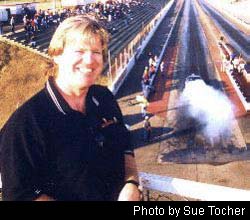
SRO No More
7/7/06

![]() n attendance parlance SRO typically stands for “Standing Room Only” or “Sold Right Out,” but at several events I’ve been to this year it’s more apt to mean, “See Racers Only.” I realize drag racing as an entertainment form has to compete with other sporting events, movies, concerts and who knows what else for consumers’ attention and wallets, but there seems to be a real dearth of spectators at the digs these days.
n attendance parlance SRO typically stands for “Standing Room Only” or “Sold Right Out,” but at several events I’ve been to this year it’s more apt to mean, “See Racers Only.” I realize drag racing as an entertainment form has to compete with other sporting events, movies, concerts and who knows what else for consumers’ attention and wallets, but there seems to be a real dearth of spectators at the digs these days.
I’m not talking national or divisional events for either of the big HRAs here, nor for any of the other touring series I cover. They certainly have attendance issues of their own, but that’s a whole ‘nother story. No, I’m thinking more of the one- or two-day events put on by a local promoter who brings in a field of Pro Mod, Quick 8, or Outlaw cars, mixes in a couple of jet cars or wheelstanders, and maybe even tops it off with fireworks—and all of it played out before dismal showings of spectators.
Maybe I’m wrong because I wasn’t there to see it, but I love to read the old race reports and view photos from the ‘60s, ‘70s and even ‘80s, and it seems there was much stronger attendance for locally promoted shows back then. On any 4th of July weekend of yesteryear, even at off-the-beaten-path strips, there invariably appeared full grandstands, full fields, and top-notch action. I bring this up now because it’s been a long, long time since I’ve attended a special event that featured all three. Sure, the on-track efforts are there and racer turnout is usually acceptable, but a strong fan presence probably is the most important element for a successful race weekend, not only from the obvious monetary standpoint, but because of the energy and fun a crowd naturally exudes.
A crowd is a self-perpetuating positive influence. It pumps up the race teams to know there are fans pulling both for and against them; it’s fun to win and hear a big cheer or listen to the excited buzz after a particularly good run flashes across the scoreboard. Likewise, a crowd’s excitement convinces each attendee they picked the right event to attend that day. Die-hard drag racing fans would be there regardless, but the casual fan who chooses to
attend a race over going to the movies or staying home to watch baseball on TV wants to know he made the right choice. If all these other people chose drag racing and are having a good time, well then, he unavoidably reasons it’s obviously been a damn good choice!On the other hand, someone who shows up and finds he and the family has all the room in the world to stretch out in the stands may initially enjoy the extra space, but eventually might wonder if that’s only because he’s just an unlucky rube who fell for the track’s advertising pitch. And it won’t matter how great the racing action may be. If it’s perceived as a non-event, the casual fan probably won’t return.
Ironically, I think the Internet may play a role in hurting live attendance figures for certain events. No doubt, the World Wide Web has been a boon for practically every sport, art and hobby in the land. Whether you’re into philatelism (not nearly as dirty as it sounds), Dr. Seussisms, or the effect of Dada on Surrealism, there are plenty of online sites available to entertain and inform you with greater depth and analysis than what was available not so long ago in the finest of university libraries. As this online magazine proves, even drag racing—as much a fringe sport as any on the worldwide stage—enjoys a significant Internet presence.